One of the reasons you’ll want to read this book again and again is to
enjoy the loving expressions between parent and child. Another is that
you can find something new each time you turn the pages, especially in
what we can learn about ways to preserve and protect the gifts of nature.
To encourage greater awareness and appreciation of the details in the
book, let’s explore some of the special points of interest together.
Did you know?
There are simple ways to tell the difference between male and female
monarchs. In the center of the hindwing on the males is a raised
black dot.
 This is the scent pouch that attracts females.
This is the scent pouch that attracts females.
Another difference is that the veins of the female’s wings are more
pronounced (bolder). In flight females appear to be darker orange. In flight
males seem to be bright orange because their wing veins are thinner.
Can you find a male and a female monarch in the book?
Now let’s take a look at the first spread in the book. By this we mean the
first two page fold out of text and artwork. You won’t believe how many
interesting things you can find in just one drawing!
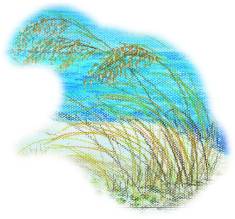 The yucca plant is also called the Spanish Bayonet. Its tall white blossoms produce
nectar when in bloom in summer and they attract the Yucca Moth.
The yucca plant is also called the Spanish Bayonet. Its tall white blossoms produce
nectar when in bloom in summer and they attract the Yucca Moth.
The wild sea oats are protected by state law. They help prevent coastal erosion
and grow up to 6 feet tall. They are surrounded by other local grasses.
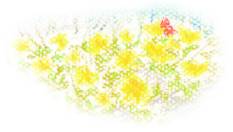 The evening primrose is the pale yellow flower that opens at sundown. It has hairy
leaves and stems as its natural protection against the harmful salt from the
ocean.
The evening primrose is the pale yellow flower that opens at sundown. It has hairy
leaves and stems as its natural protection against the harmful salt from the
ocean.

The dollar plant, also called the beach pennywort, is the vine growing flat
on the ground. The leaves curve downward to protect them from the salt spray.
 The gaillardia, commonly called the blanket flower, is the companion of the evening
primrose. It has daisy-type blooms, a red center, and a yellow edge.
The gaillardia, commonly called the blanket flower, is the companion of the evening
primrose. It has daisy-type blooms, a red center, and a yellow edge.
On the second spread of the book, you can see a close-up of the blanket flower
and sea oats.
Did you know?
The plants on the beach help protect and preserve the sand dunes from coastal
erosion, and the features of each plant help preserve and protect them in the
coastal environment. Other plants in the book preserve and protect butterflies
by providing nectar for them.
Monarchs sip nectar (sweet juice) of plants. Even the dandelion, the plant
Jake is holding on the cover of the book, is a good source of nectar!
Mouth or—proboscis—shaped like a long, thin straw. It curls up when the monarch
is not eating, and uncurls to sip the nectar.
 There are many varieties of nectar flowers pictured in the flower pot on spread
number six. You can find marigolds, Mexican sunflowers, lantana, sweet pea
blossoms, steeplebush and wild blue phlox.
There are many varieties of nectar flowers pictured in the flower pot on spread
number six. You can find marigolds, Mexican sunflowers, lantana, sweet pea
blossoms, steeplebush and wild blue phlox.
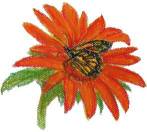
One of the monarchs’ favorite foods is the Mexican Sunflower. Visit our
Look and Listen photo gallery to see photos
of this lovely flower and many other nectar flowers growing at the Roper Mountain
Science Center.
Did You Know?
 The Carolina Wren is the state bird of South Carolina. Look under the flowers to
see the state bird of South Carolina. There are many wren varieties. Notice the
stripe above the eye on this Carolina Wren.
The Carolina Wren is the state bird of South Carolina. Look under the flowers to
see the state bird of South Carolina. There are many wren varieties. Notice the
stripe above the eye on this Carolina Wren.
Did You Know?
Migrating monarchs need our help. Monarchs are the only butterflies known
to migrate to specific destinations in large numbers and to make a two way journey!
The monarchs fly from Canada or the northern part of the United States to
Mexico in 6-8 weeks time. Sometimes the monarch butterflies crawl in the
rest of the way because they have so much dust on their wings when they
arrive in the mountains after their journey south. You will find many
on the ground in the book.
Did You Know?
The Sierra Madre Mountains of Mexico are the overwintering grounds for
monarchs. We must find ways to help preserve
 these forests. We describe the important connection between the monarchs,
the oyamel fir forests, and the people of Mexico in the Monarchs and Me
section at the end of the book, and there is much more to learn in the
Reading and Research section of this site.
In fact, this connection is so important to us that we printed an edition of
Jake and the Migration of the Monarch in Spanish!
these forests. We describe the important connection between the monarchs,
the oyamel fir forests, and the people of Mexico in the Monarchs and Me
section at the end of the book, and there is much more to learn in the
Reading and Research section of this site.
In fact, this connection is so important to us that we printed an edition of
Jake and the Migration of the Monarch in Spanish!
Did You Know?
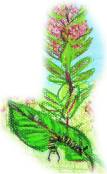
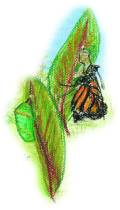 Look at the page in the book showing the monarch life cycle. The female monarch
only lays her eggs on milkweed, and usually only one per plant. The ivory
colored eggs are dome shaped and the caterpillar will emerge in 3-5 days. The
white, black, and yellow caterpillars shed their skin five times over a two
week period. It then stays inside the chrysalis for 5-15 days and comes out
a beautiful monarch.
Look at the page in the book showing the monarch life cycle. The female monarch
only lays her eggs on milkweed, and usually only one per plant. The ivory
colored eggs are dome shaped and the caterpillar will emerge in 3-5 days. The
white, black, and yellow caterpillars shed their skin five times over a two
week period. It then stays inside the chrysalis for 5-15 days and comes out
a beautiful monarch.
Did You Know?
The common milkweed with its lovely pink show is found in the
book. Monarchs
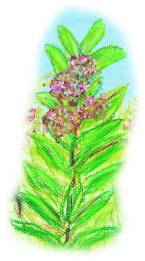 depend on milkweed for their survival. There are
many varieties of milkweed, the only host plant for the monarch butterfly.
Milkweed is often cut down because it is a weed, but its flowers are quite
beautiful, and its purpose magnificent. Go to
Things to Grow to learn
more about planting milkweed, and
Look and Listen to see
beautiful photographs of a number of milkweed growing in the Roper
Mountain Science Center, Greenville, S.C. Books about
wildflowers may be a good place to begin learning about some of
the varieties in your area.
depend on milkweed for their survival. There are
many varieties of milkweed, the only host plant for the monarch butterfly.
Milkweed is often cut down because it is a weed, but its flowers are quite
beautiful, and its purpose magnificent. Go to
Things to Grow to learn
more about planting milkweed, and
Look and Listen to see
beautiful photographs of a number of milkweed growing in the Roper
Mountain Science Center, Greenville, S.C. Books about
wildflowers may be a good place to begin learning about some of
the varieties in your area.
Did You Know?
One important way to help preserve and protect our view of the night sky
is to turning off unnecessary lights
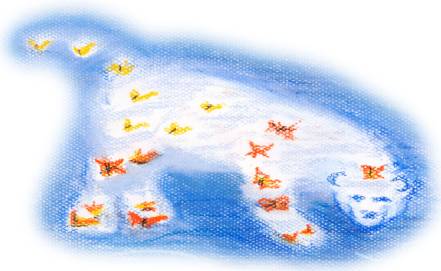
The constellation we call the Big Dipper is actually a part of the
constellation known as the Great Bear. Look at the spread showing the
butterflies in the shape of constellations. You will find that the
butterflies taking the shape of the Big Dipper are given a more yellow
color to help you see that relationship.
Bonus Question:
What is one of nature’s most beautiful and amazing creatures? Of course,
you got it right--The Monarch Butterfly




